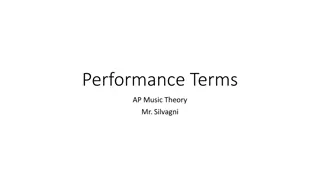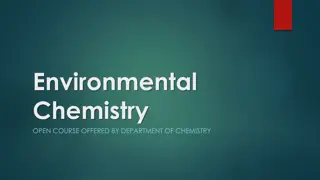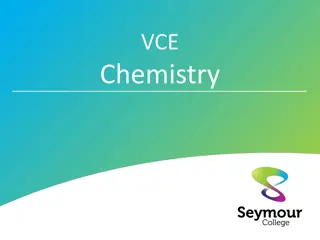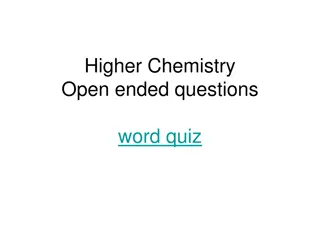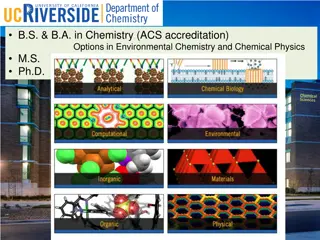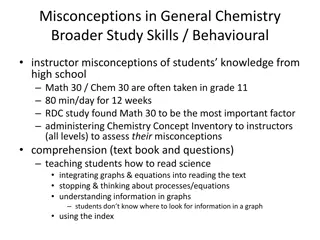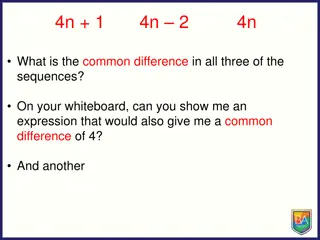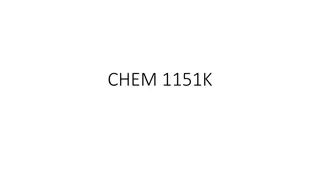Understanding Common Chemistry Terms and Processes
Explore essential chemistry concepts such as matter, pH, acids, bases, mixtures, solutions, vaporization, sublimation, deposition, condensation, and freezing. Learn about the different states of matter, types of mixtures, and physical changes occurring in substances. Enhance your knowledge of chemistry fundamentals with detailed definitions and examples.
Download Presentation

Please find below an Image/Link to download the presentation.
The content on the website is provided AS IS for your information and personal use only. It may not be sold, licensed, or shared on other websites without obtaining consent from the author. Download presentation by click this link. If you encounter any issues during the download, it is possible that the publisher has removed the file from their server.
E N D
Presentation Transcript
MATTER Definition: term for any type of material; anything that has mass and takes up space 4 primary states of matter There may be limitless states of matter Solid Liquid Gas plasma
pH Definition: measure of Hydrogen ion concentration measure of the acidity or basicity of an aqueous solution
ACID Definition: substance that gives off H+ ions in water and has a pH < 7
BASE Definition: A compound that gives off OH- ions in water and have a pH > 7
MIXTURE Definition: A mixture is what you get when you combine two or more substances No chemical reaction occurs Can separate substances again Example: different fruits
MIXTURE TYPES Heterogeneous Definition: parts of a mixture that are not evenly distributed Homogeneous Definition: parts of a mixture that are evenly distributed
SOLUTION Definition: where one substance is evenly and completely dissolved into another Chemical reaction occurs Substances can not be separated Example: air Nitrogen + Oxygen Example: carbon dioxide in soda
VAPORIZATION Definition: a change from liquid to gas Example: Water
SUBLIMATION Definition: a change from solid to gas Example: dry ice
DEPOSITION Definition: a change from gas to solid Example: frost
CONDENSATION Definition: a change from a gas to liquid Example: Water gathering on a cold bottle
FREEZING Definition: a change from liquid to solid Example: ice
MELTING Definition: a change from solid to liquid Example: candle wax
REFRACTION Definition: bending of light as it passes from one substance to another
ELEMENT Definition: a substance that cannot be separated into simpler substances
PERIOD Definition: a horizontal row of elements in the periodic table
FAMILIES/GROUPS Definition: a vertical row of elements in the periodic table These elements have similar properties
PROTONS Definition: positively charged particles in the nucleus Hydrogen ion, H+ is a proton
NEUTRONS Definition: neutrally charged particles in the nucleus
ELECTRONS Definition: negatively charged particles outside the nucleus
VALENCE ELECTRONS Definition: electrons in the outer shell of an atom Involved in forming bonds to adjacent atoms
ATOMIC NUMBER Definition: the number of protons in the nucleus of an atom
ISOTOPES Definition: atoms of the same element that have different numbers of neutrons
MOLECULE Definition: atoms that are connected by chemical bonds
COMPOUND Definition: a pure chemical substance consisting of two or more different elements Water, H2O
COVALENT BOND Definition: a chemical bond that involves the sharing of electron pairs between atoms
IONIC BOND Definition: bonds in which atoms that have lost one or more electrons and atoms that have gained one or more electrons. bonding animation
CATION Definition: positively charged atom or group of atoms Examples: Calcium Ca2+, SilverAg+, Potassium K+
ANION Definition: negatively charged atom or group of atoms Examples: Fluoride F-, Chloride Cl-, Iodide I-
CHEMICAL FORMULA Definition: An expression which states the number and type of atoms present in a molecule of a substance.
CHEMICAL REACTION Definition: A process where a set of substances undergo a chemical change to form a different substance.
REACTANT/REAGENT Definition: substances that are used to bring about a chemical reaction any substance that is consumed or used up during the reaction Reactant
PRODUCT Definition: The substance that is produced by a chemical reaction Product
CATALYST Definition: substance that speeds up a chemical reaction but is chemically unchanged Example: Enzymes are catalysts because they allow the reactions that take place in the body to occur fast enough that we can live
CONSERVATION OF MASS Definition: matter can be neither created nor destroyed The mass of an object or collection of objects never changes, no matter how the parts are rearranged
STOICHIOMETRY Definition: the part of chemistry that studies amounts of substances that are involved in reactions
MOLE Definition: measures the number of particles in a specific substance Avogadro's number = 6.02 x 1023 Used to convert between atoms/molecules and grams





